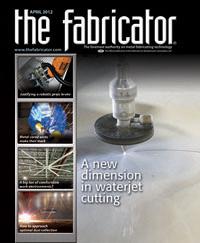Senior Editor
- FMA
- The Fabricator
- FABTECH
- Canadian Metalworking
Categories
- Additive Manufacturing
- Aluminum Welding
- Arc Welding
- Assembly and Joining
- Automation and Robotics
- Bending and Forming
- Consumables
- Cutting and Weld Prep
- Electric Vehicles
- En Español
- Finishing
- Hydroforming
- Laser Cutting
- Laser Welding
- Machining
- Manufacturing Software
- Materials Handling
- Metals/Materials
- Oxyfuel Cutting
- Plasma Cutting
- Power Tools
- Punching and Other Holemaking
- Roll Forming
- Safety
- Sawing
- Shearing
- Shop Management
- Testing and Measuring
- Tube and Pipe Fabrication
- Tube and Pipe Production
- Waterjet Cutting
Industry Directory
Webcasts
Podcasts
FAB 40
Advertise
Subscribe
Account Login
Search
Delivering orders on time, every time
How manufacturing cells may make scheduling easier
- By Tim Heston
- April 16, 2012
- Article
- Shop Management
This year at The FABRICATOR’s Leadership Summit, the 7th Annual Metal Matters, managers from several major OEMs talked about supply chain efficiency. All the efforts speakers talked about—bringing in preferred suppliers early in the design process so that product features take into account metal fabrication challenges from the get-go; disaster plans; supply chain transparency—really boiled down to one thing: minimizing risk. A fabricator’s customers want a quality product delivered at the right place and time.
Translation: Stellar on-time delivery is paramount.
Listening to the panel, which included representatives from Caterpillar and Rockwell Automation, I glanced over at fellow conference attendee Jerry Ward, vice president of Alpharetta, Ga.-based Metcam. The company now organizes most of its processes in cells: A punch press feeds into several press brakes, hardware insertion presses, and (depending on the cell) a projection welding machine.
By implementing cells, Metcam essentially reduced the number of planned steps required to make a part. Yes, a part still needs to be punched, formed, and have hardware inserted, but because cross-trained operators carry parts through multiple steps of fabrication, from a planning perspective all three processes can be thought of as one “step.”
Metcam isn’t the only one to do this. As just a couple more examples, at Cupples’ J&J Co., a Jackson, Tenn., fabricator, operators run both a laser cutting system and press brakes in one cell; in another cell, operators manage several brakes and robotic welding. Phoenix Products, a high-mix, low-volume lighting product manufacturer in Milwaukee, has a comprehensive fabrication cell with a punch press, press brakes, and a welding station. It is impressive to see one operator monitor a punch press, move pieces over on a cart to the press brake, form them, then move over to the welding area and pick up a gas tungsten arc welding torch. Talk about versatility.
The more I see shops arranging machines like this, the more I think cellular manufacturing might indeed make more sense for many shops in this business, and it may be one way to overcome a fabricator’s scheduling woes. In a 2011 financial benchmark survey from the Fabricators & Manufacturers Association, more than half of respondents said they delivered 80 to 95 percent on time. A full 12 percent said they had on-time delivery rates of less than 80 percent.
Considering the demands from OEMs, stellar on-time delivery now is just as important as quality, and cells may help a fabricator attain it. Traditional thinking says that lean manufacturing’s “hard cell” doesn’t apply to most job shop work, and that’s true. It makes no sense to design a product-specific cell unless that product is produced at a certain volume and customer demand is predictable. But in most precision sheet metal operations, many parts or part families at least share some standard operations. Why not group some of those processes together?
Another benefit: With a team of workers following parts through a cell, quality problems are caught almost as they happen—after, say, only one nest of parts in the punch press or one short run on a press brake—not after hundreds of parts already have been punched or bent.
Perfecting a schedule may take more than grouping certain machines into cells. Consider what Rajan Suri has to say. Founder of the University of Wisconsin-Madison’s Center for Quick Response Manufacturing (www.qrmcenter.org), which focuses on an improvement methodology for high-mix, low-volume operations, Suri proposes a part flow system that controls capacity levels.
High-mix, low-volume operations must deal with unavoidable variability. Part design changes and hot jobs are just part of the gig, and a shop needs excess capacity to account for that work.
Suri proposes something called POLCA, or paired-cell overlapping loops of cards with authorization, as described in his book, It’s About Time: The Competitive Advantage of Quick Response Manufacturing. A “loop” is a connection between two manufacturing cells—let’s say the fabrication cell (a punch press, press brake, and hardware insertion press) and the welding cell. Each cell has a list of authorized jobs to complete for the day, but workers don’t just start at the top of the list. Instead, they see if they have the required capacity-control (POLCA) cards from operations downstream in the routing. If they don’t have a card, that means the downstream operation doesn’t have capacity to accept more work, so they move on to the next job on the schedule. If no capacity-control cards are present, workers can perform preventive maintenance or brainstorm improvement ideas—far more valuable than producing parts that would create excess WIP.
Each card shows an origination cell and a destination cell, and represents a certain amount of capacity. Say a job in the fabrication cell is destined for a certain welding cell. When a fabrication cell receives a card from the downstream welding cell, that card signifies the welding cell has available capacity and can accept more work. So when the fabrication cell workers receive that card, and they see the job has been authorized on the shop schedule, they can start that job. The same logic applies to cells further along the part routing. When workers in a welding cell receive a job, they can start that job only if they have a capacity-control card from the finishing cell. If not, they must move to other authorized jobs that do have cards attached to them. Again, cards aren’t tied to specific products but instead signify a certain amount of capacity. A large job may require so much capacity that a cell will need two or even more cards to begin the work.
The system boils down to a simple statement: Don’t give me more work until I’m finished with what I’ve got, a concept that pervades other manufacturing improvement methodologies as well. There’s much more to POLCA, of course, as described in Suri’s book. And as always, the devil’s in the details. This isn’t an endorsement of any one method, either, and cells certainly aren’t the answer for every shop. But it does seem that any custom-manufacturing improvement methodology—be it lean manufacturing practices adapted for high-mix, low-volume work; theory of constraints, managing part flow around an operation’s bottleneck; or quick-response manufacturing—ensures a shop carefully manages its capacity. Complications abound, such as managing outsourced processes, but generally, managing capacity seems to help make scheduling much easier.
Stellar on-time delivery seems to be that last great hurdle to operational perfection in metal fabrication. These days a shop can’t stay in business for long without topnotch quality. In the coming years, the same may be said about world-class on-time delivery.
About the Author

Tim Heston
2135 Point Blvd
Elgin, IL 60123
815-381-1314
Tim Heston, The Fabricator's senior editor, has covered the metal fabrication industry since 1998, starting his career at the American Welding Society's Welding Journal. Since then he has covered the full range of metal fabrication processes, from stamping, bending, and cutting to grinding and polishing. He joined The Fabricator's staff in October 2007.
subscribe now

The Fabricator is North America's leading magazine for the metal forming and fabricating industry. The magazine delivers the news, technical articles, and case histories that enable fabricators to do their jobs more efficiently. The Fabricator has served the industry since 1970.
start your free subscription- Stay connected from anywhere

Easily access valuable industry resources now with full access to the digital edition of The Fabricator.

Easily access valuable industry resources now with full access to the digital edition of The Welder.

Easily access valuable industry resources now with full access to the digital edition of The Tube and Pipe Journal.
- Podcasting
- Podcast:
- The Fabricator Podcast
- Published:
- 04/16/2024
- Running Time:
- 63:29
In this episode of The Fabricator Podcast, Caleb Chamberlain, co-founder and CEO of OSH Cut, discusses his company’s...
- Trending Articles
AI, machine learning, and the future of metal fabrication

Employee ownership: The best way to ensure engagement

Steel industry reacts to Nucor’s new weekly published HRC price

Dynamic Metal blossoms with each passing year

Metal fabrication management: A guide for new supervisors

- Industry Events
16th Annual Safety Conference
- April 30 - May 1, 2024
- Elgin,
Pipe and Tube Conference
- May 21 - 22, 2024
- Omaha, NE
World-Class Roll Forming Workshop
- June 5 - 6, 2024
- Louisville, KY
Advanced Laser Application Workshop
- June 25 - 27, 2024
- Novi, MI



























